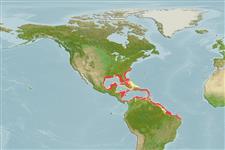Common names from other countries
Environment: milieu / climate zone / depth range / distribution range
Ecología
; rango de profundidad 0 - 366 m (Ref. 83435), usually 8 - 11 m (Ref. 83435). Tropical, preferred 24°C (Ref. 107945); 38°N - 6°S, 98°W - 35°W (Ref. 83435)
Distribución
Países | Áreas FAO | Ecosistemas | Ocurrencias, apariciones | Introducciones
Western Atlantic.
Length at first maturity / Tamaño / Peso / Age
Maturity: Lm ? range ? - ? cm Max length : 6.3 cm SHL macho / no sexado; (Ref. 344); edad máxima reportada: 2.00 años (Ref. 8702)
Shell outline almost circular, valves very inflated, wing-like projections relatively poorly developed. Surface sculpture of about 20 ribs, smooth square in cross-section. Hinge straight. Colour: upper valve bright, variable, ranging from brown to red to lavender rose to whitish with purplish or reddish mottlings, colour of lower valve much lighter, whitish with lighter markings.
Life span: 18 to 24 months (Ref. 350). Lives in beds in shallow to moderately deep water, usually on (or buried in) sandy bottoms (Ref. 344). Also in seagrass and algae beds (Ref. 106861).
Life cycle and mating behavior
Madurez | Reproducción | Puesta | Huevos | Fecundidad | Larva
Spawning and recruitment occur throughout the year, with peaks in late autumn and spring.
Leal, J.H. 2003. (Ref. 344)
IUCN Red List Status (Ref. 130435)
CITES status (Ref. 108899)
Not Evaluated
Not Evaluated
Human uses
Pesquerías: muy comercial
FAO - pesquerías: landings | FishSource | Sea Around Us
Herramientas
Fuentes de Internet
Estimates based on models
Preferred temperature
(Ref.
115969): 23.7 - 28, mean 26.9 (based on 680 cells).
Resiliencia
Alto, población duplicada en un tiempo mínimo inferior a 15 meses (K=1.88-3.06; tmax=2).
Prior r = 1.01, 95% CL = 0.66 - 1.51, Based on 1 data-limited stock assessment.
